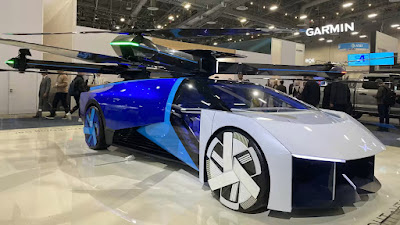ONE BIG DREAMS - In the ever-evolving realm of automotive innovation, a captivating narrative unfolds, revealing hidden treasures that ignite the passion of both car enthusiasts and industry insiders. One such gem is the Olmos 640 R One, a creation born from the ingenuity of the relatively unknown French car artisan, Manuel Olmos.
 |
| The Olmos 640 R One stands as a stunning automotive supercar, a creation of Manuel Olmos, a skilled automotive craftsman hailing from Meximieux in Ain, France. (Picture from: Olmos Racing) |
The journey of this exotic sports car commenced in 2011 when
Olmos, armed with a unique skill set spanning electrical engineering, pneumatics, mechanics, and goldsmithing, embarked on the transformative task of sculpting a foam block in his modest garage—a block destined to metamorphose into a luxurious automobile.
 |
| The Olmos 640 R One prototype underwent development for approximately six years, involving an impressive 18,000 work hours since 2011. (Picture from: Olmos Racing) |
The driving force behind
Olmos' ambitious project was his perception that France lacked an iconic luxury car on par with globally renowned brands like
Pagani,
Zenvo, or
Lamborghini. Frustrated with the frequent disappointment of concept cars never making it to production, he invested not only his skills but also a substantial €1 million of his savings to breathe life into his visionary project.
 |
| The Olmos 640 R One boasts a captivating sporty design that prioritizes safety, incorporating various components crafted from titanium, carbon, and Nomex for enhanced durability. (Picture from: EncyclAutomobile.fr) |
The culmination of six years and an impressive 18,000 work hours yielded the Olmos 640 R One prototype in 2017. This automotive masterpiece boasts a titanium Nomex-carbon fiber chassis, a flat, ground-effect underfloor, and is powered by a formidable yet unspecified LS V8, delivering an impressive 640 horsepower. Adding an extra layer of intrigue is the subtle indication of an unapparent hybrid setup in the production model, potentially propelling the power output to an astonishing 1,000 horsepower.
 |
| The formidable LS V8 powering the Olmos 640 R One is discreetly positioned in the rear center, enhancing its performance. (Picture from: Olmos Racing) |
The meticulous evolution of the car's design and optics, entrusted to
Pascal Fotia, a skilled compatriot coachbuilder, mirrors
Olmos' unwavering commitment to perfection. The vehicle, resplendent in immaculate whiteness, made its grand debut at the
Époqu’auto show in Lyon, serving as a testament to
Olmos' unwavering dedication and craftsmanship.
 |
| The meticulous evolution of the 640 R One's design and optics, entrusted to Pascal Fotia, a skilled compatriot coachbuilder, mirrors Olmos' unwavering commitment to perfection. (Picture from: Olmos Racing) |
Despite the technical prowess and aesthetic allure of the
Olmos 640 R One, its substantial price tag, commencing at
€600,000 or approximately
£530,000, seems to have given pause to potential buyers. Nevertheless, this financial hurdle has not dampened
Olmos' spirits; he remains steadfast in his commitment to the artisanal approach to car manufacturing, envisioning each car as a unique masterpiece, preserving exclusivity and individuality.
 |
| The Olmos 640 R One resplendent in immaculate whiteness, made its grand debut at the Époqu'auto Lyon 2018. (Picture from: Olmos Racing) |
The
Époqu'auto Lyon 2018 emerged as a pivotal stage for
Olmos to gauge public interest and potentially attract investors or partners. The response was remarkable, with a captivated audience and professionals witnessing the unveiling of this automotive marvel. The subsequent stops on the
Olmos 640 R One's journey included potential appearances at the
Cannes Festival and the
Grand Prix du Mans.
Regrettably, as of today, updates on Manuel Olmos and his 640 R One supercar remain elusive, as if both the car and its creator have vanished from the limelight. Questions linger unanswered—was the sports car actually produced, and if so, how many units found their way into the world?
Note: This blog can be accessed via your smart phone.

 In the automotive world, renowned designers like Alex Tremulis ventured into uncharted territory, conceptualizing flying saucer designs. This trend extended beyond the drafting board, with manufacturers materializing these imaginative ideas into real, tangible forms. Examples include the 1953 Alfa Romeo 1900 C52 Disco Volante, the futuristic 1958 Ford X-2000, the gyroscopic wonder of 1967 Gyro-X, and the contemporary 2016 Alfa Romeo Disco Volante Spyder, each defying expectations.
In the automotive world, renowned designers like Alex Tremulis ventured into uncharted territory, conceptualizing flying saucer designs. This trend extended beyond the drafting board, with manufacturers materializing these imaginative ideas into real, tangible forms. Examples include the 1953 Alfa Romeo 1900 C52 Disco Volante, the futuristic 1958 Ford X-2000, the gyroscopic wonder of 1967 Gyro-X, and the contemporary 2016 Alfa Romeo Disco Volante Spyder, each defying expectations.




 And it's had been proven by the automaker nearly three decades later, in 2022, it collaborates with TheArsenale had succeded to fly the Air4 prototype, in celebrating the 60th anniversary of its legendary Renault 4L model.😄 *** [EKA | FROM VARIOUS SOURCES | LAUTOMOBILEANCIENNE | AUTO-MOTO | CLASSICDRIVER | CONCEPTCARZ | THRILLIST | SECRET-CLASSIC | PROEKTOR ]
And it's had been proven by the automaker nearly three decades later, in 2022, it collaborates with TheArsenale had succeded to fly the Air4 prototype, in celebrating the 60th anniversary of its legendary Renault 4L model.😄 *** [EKA | FROM VARIOUS SOURCES | LAUTOMOBILEANCIENNE | AUTO-MOTO | CLASSICDRIVER | CONCEPTCARZ | THRILLIST | SECRET-CLASSIC | PROEKTOR ]
































